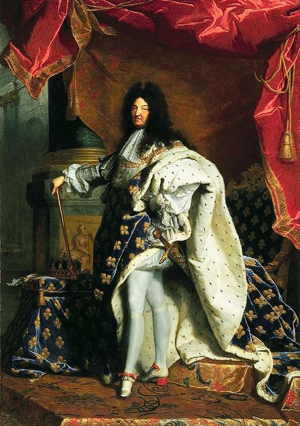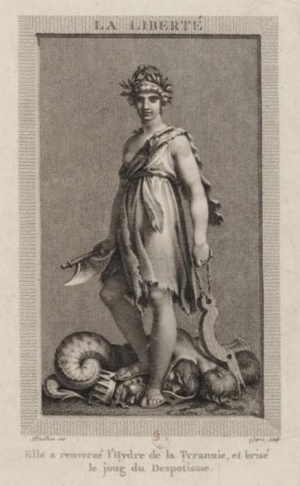
[Hyacinth Rigaud, “Louis XIV” (1701)]

[Pierre-Paul Prud’hon, “Liberty” (1793) slaying the hydra monster of tyranny]
I interpret “liberal history” in several ways. It might mean
(1.) The history of the classical liberal tradition, which has at least two components:
- a history of how and when liberal ideas first emerged and then evolved over time – so the “intellectual history” of liberalism;
- a history of “liberal movements” where liberal minded people organized to join forces in order to change / reform society along the lines suggested by their liberal philosophy and values – so a social and political history of liberal reform movements, such as the movement to abolish slavery, or to abolish tariffs (the Corn Laws in England)
(2.) The history of societies or entire countries during periods when liberal ideas and movements had sufficient strength to influence the course of history, such as the late 18th century in north America and western Europe when revolutions took place (e.g. Palmer’s “The Age of Democratic Revolutions”), or the 19th century when many European countries enacted liberal reforms and restructured their societies according to some liberal principles (democratic reform, free trade, constitutional limits on the power of the state, freedom of speech) (Hamerow’s “The Birth of a New Europe”)
(3.) The use of liberal political, economic, and social theory to analyse the power structures, government policies, and the problems they caused in the broader society, in writing the history of any society (liberal or illiberal). For example the use of classical liberal class analysis and theory of “interventionism” developed by Mises, to study the nature of the class system of Ancient Greece and Rome, the class structure and the economic crises faced by “old regime” states in Europe during the 17th and 18th centuries, or communist regimes during the course of the 20th century.
I have tried to make contributions to all three forms of “liberal history” which I have listed here. Since 1987 I have been teaching and lecturing on the history of the classical liberal tradition (history of ideas) and its impact on the world (political, economic, social, and military history). This has taken the path of formal courses taught at university (the University of Adelaide 1986-2001), occasional lectures/seminars for groups such as the Institute for Human Studies (since 1991), the Center for Liberal Studies, the Centre for Independent Studies (since 1999), and the Mannkal Center, as well as lectures to student groups and the general public wherever and whenever the opportunity arose (Students for Liberty, Bastiat Societies all across the US).
For example,
(1.) On the history of classical liberal ideas and the movements they inspired to bring about liberal reforms see the following:
- about half of my full-year course given at the University of Adelaide on “Liberal Europe and Social Change, 1815-1914″ (1987) was devoted to an intellectual history of 19th century classical liberal thought and the other half to the movements for reform which it inspired. Course Reading Guide and Lecture Notes.
- the entire one semester upper level course on “The Enlightenment: Ideas of Criticism and Reform in an International Context” (1990) dealt with both ideas and liberal reform movements before the French Revolution. Course Reading Guide.
- as did the short three week module in a first year subject “The Old Regime, Enlightenment, and Revolution in the 18th Century” (2000). Lecture Notes and Seminar Reading Guide.
- and the lecture/seminar series I have been giving since 2006 on “The Classical Liberal Tradition: A 400 Year History of Ideas and Movements” (which is currently being revised and rewritten) here.
(2.) On the history of more extended periods when European societies were undergoing radical social and economic changes inspired largely by classical liberal ideas see:
- significant portions of the course “Liberal Europe and Social Change, 1815-1914” (1987). Course Reading Guide and Lecture Notes.
- most of the semester length first year course on modern European history “Revolution(s) and the Struggle for Emancipation in Europe: The Long Nineteenth Century, 1789-1914″ (1998-1999). Lecture Notes and Seminar Reading Guide.
(3.) On liberal social theory to explain historical events, my focus has been on classical liberal theories of class analysis and how it can be used to explore the tensions within societies which lead to opposition and even violent resistance (revolutions). My work on CLCA as a social theory can be seen here, and my application of this theory to specific historical moments in the following courses:
- “The Old Regime, Enlightenment, and Revolution in the 18th Century” (2000). Lecture Notes and Seminar Reading Guide.
- “Revolution(s) and the Struggle for Emancipation in Europe: The Long Nineteenth Century, 1789-1914″ (1998-1999). Lecture Notes and Seminar Reading Guide.
- and the numerous lecture/seminars I have given on class analysis for the IHS and other groups which are listed here.
The trajectory of my teaching, lecturing, and research has followed a fairly circuitous path but I believe that in spite of these twists and turns I have pursued a consistent approach to the study of history, namely the struggle between “liberty” and “power”. By this I mean that a select group ( a ”class”) has commonly enjoyed positions of power and privilege at the expense of ordinary people; that this power and privilege has been challenged at various times, first intellectually (the Enlightenment in the 18th century, and then by the ideologies of liberalism and socialism in the 19th century) and then politically, sometimes peacefully through gradual reform, and sometimes violently through revolution; this challenge to entrenched power and privilege resulted sometimes in radical and systemic change (particularly in post-revolutionary America) and at other times to only partial and temporary changes which were limited or even undone by the “counter-revolutionary” activities of the surviving members of the old regime. Nevertheless, the end result by the end of the 19th century was a new kind of society in “the West” with many important liberal institutions and practices which dramatically improved the lot of the ordinary working person.
Yet, in spite of these liberal reforms there remained powerful groups who wished to undo or moderate these reforms and to reassert their power and reclaim their privileges beginning in the 1870s and 1880s (Mayer’s “The Persistence of the Old Regime in Europe”). This took the form of the reappearance of protectionism for well-connected agricultural and industrial interests, the policies of colonialism and imperialism which saw the carving up of the world into spheres of interest and exclusive trading blocks, the formation of mass conscript armies and a naval arms race, the creation of a new bureaucratic regulatory state, and the beginnings of a “transfer” or welfare state.
A more coherent chronological statement of my view of the evolution of modern European history between 1750 and 1914 would consist of the following main points:
- a description of the power and privileges of those groups /classes who benefited from the old regime (church, state, and military), and the ideas which justified and legitimized them
- the critique of these powers and privileges during the Enlightenment, both by (proto) “liberals” and by (proto) “socialists”
- the insoluble “crisis” of the old regime created an opportunity for more radical reform, even violent revolution, as happened in north America and then France and parts of occupied Europe
- these revolutions allowed many different factions with very different ideas of what should be done to reform society to jostle for power within the new regimes: there were liberal factions, socialist/interventionist (Jacobin) factions, republican/democratic factions, and defenders of the old order (church, aristocracy, monarchy, military); very rarely did the “liberal” faction win a complete victory (possibly they did for a brief period in America – Jonathan Israel, “The Expanding Blaze How the American Revolution Ignited the World, 1775–1848”), thus the “liberal revolution” was an incomplete and unfinished one
- in most cases, the revolutions were followed by a partial “restoration” of the old order, but since the underlying political and economic problems had not been resolved there gradually emerged a new generation of critics of the old regime in the form of modern liberalism and socialism
- this criticism led to the mobilisation of groups (using their newly enfranchised status as voters) to agitate and often get significant reforms during the course of the 19th century, such as free trade, freedom of speech, deregulation of parts of the economy, constitutional limits to state paper, and the rule of law
- at the same time the remnants of the old order continued to defend their powers and privileges, often by adapting to the demands of the growing liberal, socialist, and democratic forces which were challenging their position, by making concessions, or by making sure they still controlled the key institutions of the state and the economy (the central bank, the judiciary, the military, the state education system)
- by the late 19th century liberalism was in decline, especially ideologically as it compromised many of its core beliefs – the “New Liberalism” – in order to appeal to working class supporters of the new socialist and labour parties; just as conservatives (Bismarck) accepted some “welfare” policies as a way to ward off violent challenges to their position from below; and socialist and Marxist parties grew in strength both politically and ideologically, thus positioning themselves to play a much more influential role in the 20th century
- the partial “liberal order” which had emerged at the turn of the 19th and 20th centuries was largely destroyed by the cataclysm of the First World War which saw massive regulation of all European economies, the suspension of most of the hard-won liberties citizens enjoyed, death and destruction of property on a massive scale, and the collapse of societies like the Russian, German, and Austro-Hungarian Empires and the coming to power of new, virulent forms of statism which the world had never seen before (communism and fascism)
